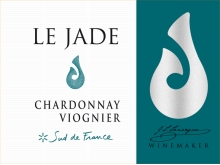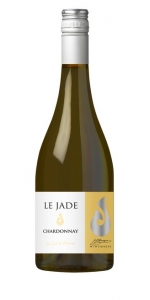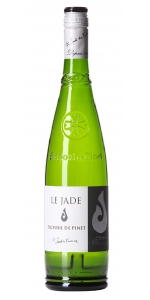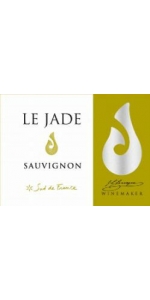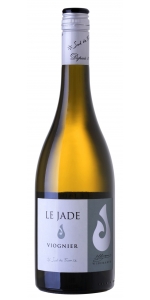Le Jade Chardonnay-Viognier 2015
| Country: | France |
| Region: | Languedoc |
| Winery: | Cave de Pomerols |
| Grape Type: | Chardonnay |
| Vintage: | 2015 |
| Bottle Size: | 750 ml |
Le Jade Chardonnay is made from 100% Chardonnay
The wine comes from south-facing vineyards planted on clay and limestone hills overlooking the Etang de Thau, a coastal lagoon situated between the port of Sète and Cap d'Agde.
Le Jade Chardonnay offers a wonderful yellow color, a complex nose of white flowers, mild tobacco and vanilla. Rich and full-bodied mouthfeel; concentrated with just a touch of sweetness.
Serve with a gratin of scallops, pan-fried sole, or grilled oysters with shallots, parsley and a touch of cream. Also great with goat cheese or chocolate cake!
Le Jade Picpoul de Pinet is made from 100% Picpoul de Pinet
Pale straw color. Delicate white flower, citrus and juicy pear aromas. Fresh, crisp, and bright acidity with mineral and saline accents. Well-balanced and easy-drinking.
A refreshing treat laced up with snappy food-friendly acidity.
Picpoul Le Jade makes a classic match with oysters on the half shell and goes very well with exotic food in general. Picpoul means lip-smacking good.
SOIL : Clay and limestone soil just a few kilometres from the reputed Etang de Thau (salted water lagoon) overlooking the Mediterranean town of Sète.
VINIFICATION : Grapes are harvested at 12°- 13° maturity
Skin maceration for several hours
Selection of drained juice after undergoing pneumatic pressure.
Cold double decantation.
Thermoregulated fermentation at 16°C
No malolactic fermentation.
Le Jade Sauvignon Blanc is made from 100 percent Sauvignon Blanc.
The wine comes from sun-drenched vineyards planted on the best terroir, selected for its physical and geographical characteristics, on clay and limestone hillsides called "costieres" (coastal region), only a few miles away from the Etang de Thau - a coastal lagoon that is situated between the port of Sete and Marseillan.
This Sauvignon Blanc boasts a silvery straw color. Crisp and fragrant white wine with wonderful aromatic intensity, fresh exotic notes, delicious fruity aromas of citrus and gooseberry. A great varietal expression, this is a zesty and refreshing wine that lingers on the palate.
Le Jade Viognier is made from 100 percent Viognier
The wine comes from sun-drenched vineyards planted on the best terroir - specially selected for its physical and geographical characteristics - on clay and limestone hillsides called "costières" (coastal region). The vineyards are only a few miles away from the Etang de Thau, a coastal lagoon that is situated between the port of Sète and Marseillan.
The color is a wonderful brilliant yellow with pearl tints. Intense and seductive aromas of ripe fruits, especially apricot, and floral notes with a hint of rose petals. The texture is very harmonious, generous, round and long. The finish is long and balanced with a good freshness.
Perfect as an aperitif, or great with richer dishes like langoustines, smoked or marinated salmon. Great too with guinea fowl in creamy or curry sauce. Serve it also with a broccoli and Roquefort soup or for dessert with a mango and pineapple tarte Tatin. An extremely versatile wine!
All older vintage wines have been purchased from a single collectors cellar. Pictures can be requested before shipment.
Le Jade Chardonnay-Viognier is made from 60% Chardonnay, 40% Viognier.
Le Jade Chardonnay/Viognier provides a mix of the ripe white fruit character of Chardonnay and the exotic fruit characters of Viognier.
An amazing combination to pair with rich seafood and pasta dishes, as well as delicate sauces and cheese.
The Cave de Pomerols Estate
Founded in 1932, this Cave Cooperative is located in the top commune of Pomerols, located between the garrigue of Pezenas and the sea dominated by the Mont St Clair in Sete. The co-op has merged with the Cave de Castelmau de Guers. They include 320 members and produce 55,000 hectoliters of wine (600,000 cases).
The Cave de Pomerols Vineyard
The members control 1,200 hectares of vineyard land (2,964 acres) of which 330 hectares (815.1 acres) are Picpoul de Pinet. Six communes are entitled to the name Picpoul de Pinet: Florensac, Pomerols, Pinet, Castelnau de Guers, Montagnac, Meze. The Pomerols vineyards stretch over vast sun-light terraces with clay/calcareous soils.
- back
Taylor Fladgate Vintage Port.
On the palate, the wine has beautifully ripe tannins, which integrate perfectly into the mid-palate, providing both structure and volume, and then break out on the finish with a firm wiry, grip. The palate closes with a powerful tide of fresh, complex fruit flowing endlessly through the finish. In the 2018, the Taylor traits of fine fruit and inner power combine seamlessly with the ripeness and depth typical of the vintage.
Corne Loup Cotes du Rhone Blanc is made from 50% Grenache Blanc, 20% Clairette, 15% Roussanne and 15% Viognier.
The wine has a pale straw color with brilliant reflection. In the nose, it displays great aromatics, mainly citrus fruit. The palate is well balanced, with a lot of finesse and persistence.
Delicious when paired with seafood (seashell and fish). It is also great by itself as an aperitif.

